GA-TACF members and collaborators:
I know it has been a while since we’ve touched base with you, and I hope this message finds you healthy and secure. I wanted to let you know that the Georgia chapter’s work has continued this spring, despite the need to avoid calling on large groups of volunteers. Below, I have listed a summary of some of the work that has been going on, almost all of which has been done by the volunteer stewards at the indicated locations (the principle leaders are listed).
We hope to get back to some safe-distance work with volunteer groups this summer, primarily in helping conduct blight-resistance tests in several orchards. I have included a photo gallery showing some images from this spring’s work. If you have done (or know of) significant recent GA-TACF work that we are unaware of, please let us know! You can contact us easiest at moc.liamg@tuntsehcag.
At some point soon, chapter president Kathy Patrick plans to call a brief on-line membership meeting using Zoom. The main order of business will be to thank members who are rotating off the board (Lynn Womack, Nathan Klaus, and Jimmy Rickard), and to elect three new board members. Details will be forthcoming soon as to how this meeting will be conducted.
Martin Cipollini, GA-TACF Science Coordinator
Demo/educational orchard plantings:
Briarlake Forest and Chestnut Grove Church – Dale Higdon (~18 seedlings total)
Sandy Creek Nature Center – Michael Wharton and Ben Jarrett (~70 seedlings)
Sloppy Floyd State Park – Elaine Thomas, David Norboge, and Robert Helton (~18 seedlings)
Charlane Plantation – Chuck Leavell (12 seedlings)
Turnip Mountain – Billy Nicholson (6 seedlings)
Cipollini GA property – Martin Cipollini (4 seedlings)
Cipollini PA property – Don Cipollini, Sr. (5 seedlings)
Krissman property – Paul Krissman (2 seedlings)
Research orchard plantings:
Flint Phytophthora screening orchard – Austin Flint, John French, and Zach Felix (~150 seedlings)
Bottomlands Phytophthora screening planting – Scott Frazier (~38 seedlings)
Roy Richards seed orchard – Kris Owens (site preparation work)
(>320 seedlings planted to demo and research orchard sites combined)
Ambrosia beetle and Phytophthora root rot spraying and mitigation work:
Berry College and Henry backcross orchards – Martin Cipollini
Flint seed orchard – Zach Felix, Keith Ray, Andrew Hodgins, and John French
Bottomlands backcross orchard – Scott Frazier
Poe (formerly Callaway) orchard – Sam Breyfogle
GA Piedmont Land Trust orchards – Dale Higdon
Orchard blight evaluations and culling of non-selected trees:
Henry backcross orchard – Martin Cipollini and Kathy Patrick
Berry House of Dreams backcross orchard – Martin Cipollini and Greg Mason
Bottomlands backcross orchard – Scott Frazier and Martin Cipollini
Leaf samples for DNA analysis (four orchard sites) – Martin Cipollini
Greenhouse/Nursery planting:
Berry College – Martin Cipollini (~600 seedlings)
Germplasm conservation project:
Scionwood collection: Ana Metaxas, John French, Scott Laseter, Martin Cipollini, Michael Blackwell, and Jack Rogers (18 clones)
Grafting work: John Hendrickson and Martin Cipollini (18 clones, ~30 rootstocks)
Leaf samples for DNA analysis: Martin Cipollini, Ana Metaxas, Jack Rogers, Natalie Bailey, John Patten Moss, TJ Treadwell (~30 wild C. dentata samples)
Pollination work:
Henry and Berry backcross orchards: Martin Cipollini, Noah Howie, and Marshall Lynch
Joe James’, SC orchard: John French and Mark Stoakes
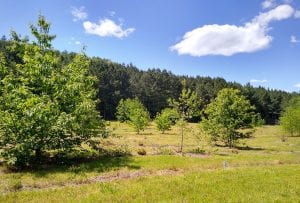
The Henry backcross orchard after culling.

Stump propagated sprout at Berry College.
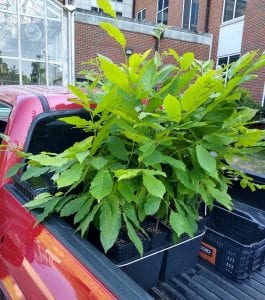
Chinese chestnut rootstocks on their way to be grafted.
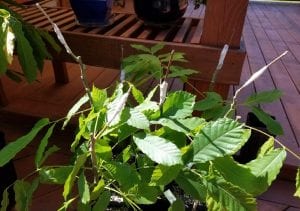
A set of grafted trees.
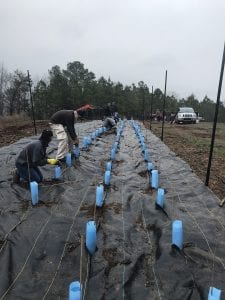
Planting the Flint Phytophthora field screening orchard.
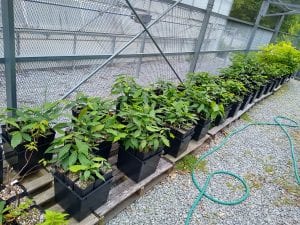
Seedlings at the Berry College nursery.
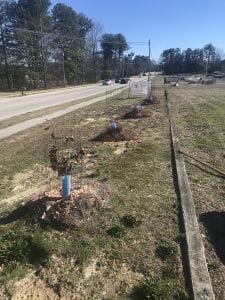
Hybrid chestnuts at Chestnut Grove church (these were planted last year, but more were added in 2020)

Dale Higdon instructs volunteers at the Briarlake Forest demostration site.

Scott Frazier’s Bottomlands Farm backcross orchard just after culling.

Berry College tree #297, our best backcross tree in this site.
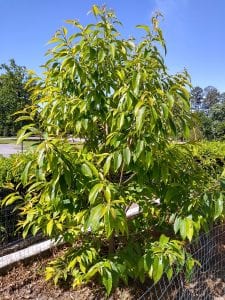
A pure American chestnut showing catkins at the Berry College germplasm conservation orchard.

